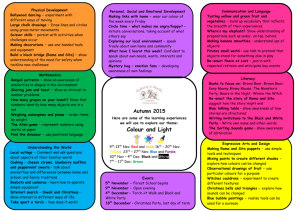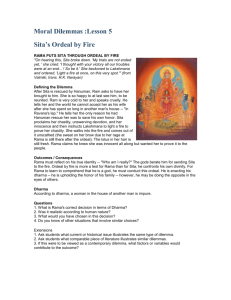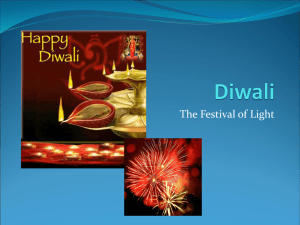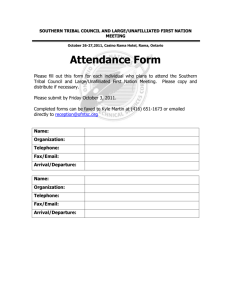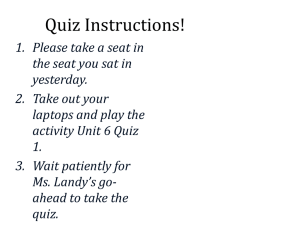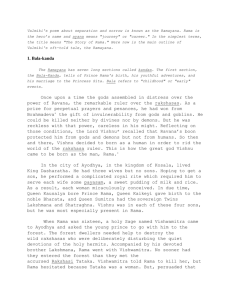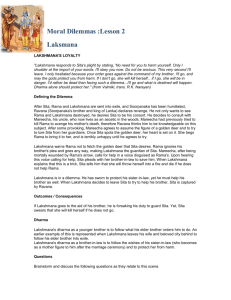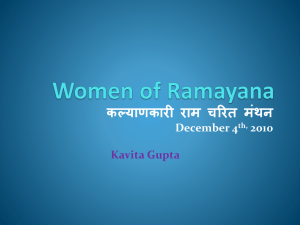Document
advertisement
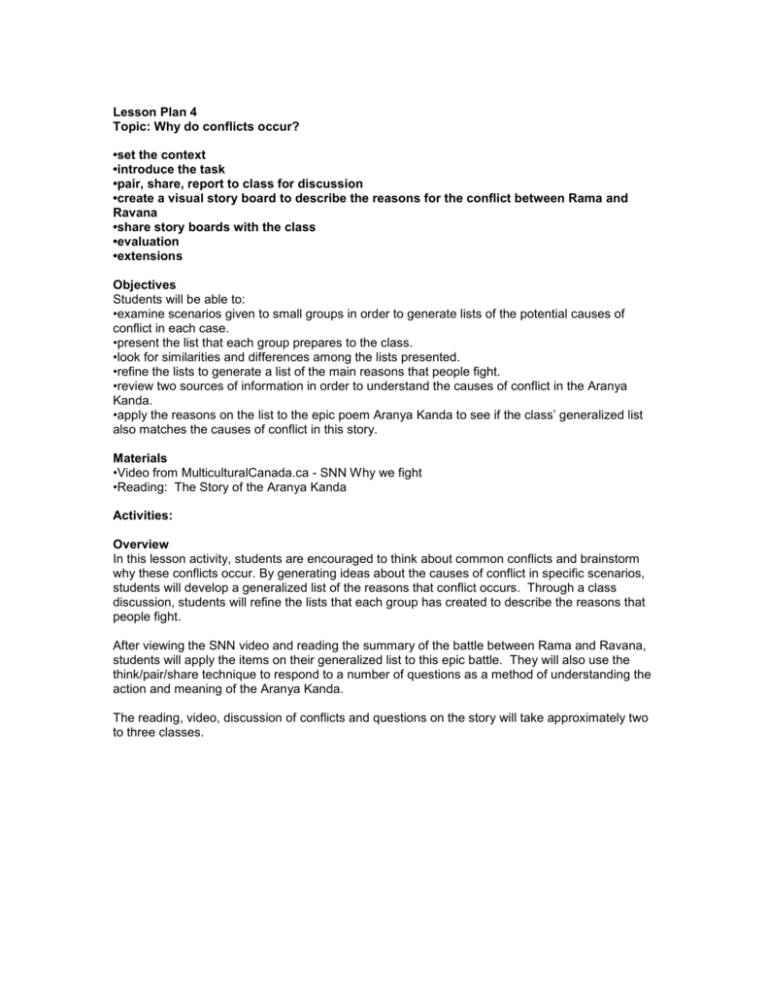
Lesson Plan 4 Topic: Why do conflicts occur? •set the context •introduce the task •pair, share, report to class for discussion •create a visual story board to describe the reasons for the conflict between Rama and Ravana •share story boards with the class •evaluation •extensions Objectives Students will be able to: •examine scenarios given to small groups in order to generate lists of the potential causes of conflict in each case. •present the list that each group prepares to the class. •look for similarities and differences among the lists presented. •refine the lists to generate a list of the main reasons that people fight. •review two sources of information in order to understand the causes of conflict in the Aranya Kanda. •apply the reasons on the list to the epic poem Aranya Kanda to see if the class’ generalized list also matches the causes of conflict in this story. Materials •Video from MulticulturalCanada.ca - SNN Why we fight •Reading: The Story of the Aranya Kanda Activities: Overview In this lesson activity, students are encouraged to think about common conflicts and brainstorm why these conflicts occur. By generating ideas about the causes of conflict in specific scenarios, students will develop a generalized list of the reasons that conflict occurs. Through a class discussion, students will refine the lists that each group has created to describe the reasons that people fight. After viewing the SNN video and reading the summary of the battle between Rama and Ravana, students will apply the items on their generalized list to this epic battle. They will also use the think/pair/share technique to respond to a number of questions as a method of understanding the action and meaning of the Aranya Kanda. The reading, video, discussion of conflicts and questions on the story will take approximately two to three classes. Questions on Conflict: In small groups, brainstorm as many reasons as you can why the following conflicts take place. Each group will have one scenario to work on, then the ideas you’ve listed will be shared with the class. Use your own experiences and what you’ve learned by watching other people to write as complete a list as possible. Scene 1 Two small toddlers are happily playing in a sandbox on a bright summer day. Suddenly a fight breaks out! What caused the fight? Possible causes: • _____________________________________________________________________ _____________________________________________________________________ _____________________________________________________________________ _____________________________________________________________________ _____________________________________________________________________ Scene 2 Two teenagers are talking in the cafeteria at lunch break. They seem very involved in their discussion and they don’t seem to notice anyone else in the room. Suddenly their voices fill the room! What are they fighting about? Possible causes: • _____________________________________________________________________ _____________________________________________________________________ _____________________________________________________________________ _____________________________________________________________________ ______________________________________________________________________ Scene 3 A teenager has a curfew of midnight. She walks in the door of her home, and her parents are there waiting for her. They look upset, and so she feels defensive. An argument breaks out. What are they fighting about? Possible causes: •_____________________________________________________________________ _____________________________________________________________________ _____________________________________________________________________ _____________________________________________________________________ ______________________________________________________________________ Scene 4 Two teams are playing a very close game of hockey. They are evenly matched, and both are working hard to control the ice. Suddenly, a fight breaks out at one end of the rink, and all the players spill out onto the ice to either fight or hold back other players from fighting! What caused the fight? Possible causes: • _____________________________________________________________________ _____________________________________________________________________ _____________________________________________________________________ _____________________________________________________________________ ______________________________________________________________________ Scene 5 The fishing season has opened on the West coast of B.C. There are a limited number of days that the boats can fish, and many boats are trying to make their entire year’s income in the short open season. Suddenly, a shouting match breaks out between the crews of two of the fishing boats. Both sides are screaming at each other! What caused the fight? Possible causes: • _____________________________________________________________________ _____________________________________________________________________ _____________________________________________________________________ _____________________________________________________________________ ______________________________________________________________________ Scene 6 Why are people in Afghanistan fighting with one another, and why are there U.N. troops fighting in the region? The causes of the war in Afghanistan are: • _____________________________________________________________________ _____________________________________________________________________ _____________________________________________________________________ _____________________________________________________________________ ______________________________________________________________________ Scene 7 Why did a World War erupt in 1939? The causes of W.W. II were: • _____________________________________________________________________ _____________________________________________________________________ _____________________________________________________________________ _____________________________________________________________________ ______________________________________________________________________ Class Discussion: Preparation: Each group needs to organize their ideas so that they can be presented to the class. It may facilitate discussion to write the possible causes of each fight onto the blackboard or onto large sheets of paper that can be posted near to each other on one side of the room. Presentation: Each group will briefly review the causes of fighting from their scene. The class can add to the list or question the validity of any of the points made. Discussion and Application: As a class, look for factors that are common to all or most of the posters. Decide on a final list by consensus with the class. Most of the violence that occurs between individuals stops short of people hurting or killing one another. We know that police officers will lay charges against people who cause conflict, and the courts will be used to prosecute those responsible for hurting or killing an opponent. Is there a similar legal system that prevents countries from fighting with one another? Investigate whether there are effective deterrents for countries that engage in starting and fighting wars. Application to the Epic Poem: Read the story of the Aranya Kanda (following), and watch the video ‘SNN Why we fight’. Does the list of “causes of fighting” list that the class prepared relate to the causes of the conflict in this story? Explain and discuss! Reading Synopsis of the Aranya Kanda The Main Characters of the Ramayana Dasaratha-- King of Ayodhya (capital of Kosala) Dasaratha had three wives and four sons. The sons were named Rama (the eldest), Bharata, and the twins Lakshmana and Satrughna. Kaushlaya -- Dasaratha's first wife, and the mother of Rama. Rama -- Dasaratha's first-born son, and the upholder of Dharma (the path of proper conduct and duty). He is revered for being a perfect son and for being a faithful husband to Sita. Sita -- Rama's wife, was the adopted daughter of King Janak. Sita was found in the furrows of a sacred field, and was regarded by the people of Janak's kingdom as a blessed child. She loves Rama so much that she follows him to live in exile in the forest. Bharata -- Rama's brother by Queen Keikeyi. When Bharata learned of his mother's scheme to banish Rama and place him on the throne, he put Rama's sandals on the throne and ruled Ayodhya in his name. Hanuman -- A leader of the monkey tribe allied with Rama against Ravana. Hanuman had many magical powers because his father was the god of the wind. Hanuman's devotion to Rama, and his supernatural feats in the battle to recapture Sita, have made him one of the most popular characters in the Ramayana. Ravana -- The king of Lanka who abducted Sita. Ravana is depicted as the ultimate villain, the evil king whose power and ruthlessness is shown by his fantastical shape. Having the power of ten men, he is shown with 10 heads, 20 arms and 20 legs. Lakshmana -- Rama's younger brother by Dasaratha's third wife, Sumitra. When Rama and Sita were exiled to the forest, Lakshmana followed in order to serve. The Aranya Kanda is a chapter in a long tale, and is a favourite topic for wayang shadow puppet performances in many parts of Asia. The central plot this story involves the kidnapping of Sita, the wife of the hero Rama, and the great battle that took place to bring her back to her home. The story begins with a great king, Dasaratha, who makes a promise to honor two requests from his second wife in order to thank her for saving his life. A wicked maid suggests that Queen Keikeyi, the second wife, should request that the king exile his oldest son, Rama, to the forest so that the second wife’s child Bharata could become the king. Although Dasaratha is heartbroken, he has made a promise that must be kept, so he orders that his eldest son, Rama, go to live in the forest for fourteen years. Rama doesn’t question his father’s orders because he is a dutiful son. He believes it is his dharma, or spiritual path, to do as his father has ordered and as his stepmother wishes. As Rama is leaving home, his wife Sita makes the decision to accompany him in his exile. The two of them leave the safety and comfort of the city together and find a small house in the forest where they can take shelter. Lakshmana, Rama’s youngest brother also joins them, leaving behind all the material possessions of the palace out of loyalty and love for his elder brother. When Bharata learned of his mother's scheme to banish Rama and place him on the throne, he searched the forest, found Rama, Sita and Lakshmana and begged Rama to return as the rightful heir to the throne. Rama refused, saying that his duty was to obey his father’s wish. Bharata returned to the kingdom as ruler, but put Rama's sandals on the throne as a symbol of Rama’s rightful place and ruled Ayodhya in Rama’s name. Bharata vowed that as soon as Rama returned, he would hand over the throne to his older brother. Eventually, the three exiles meet a cannibal demon named Surpanakha, the sister of Ravana. She tries to seduce Rama and Lakshmana, but they refuse her. Surpanakha then tries to kill Sita. Lakshmana fights her and cuts off her nose and ears. When Ravana, Surpanakha’s brother, hears of her injuries, he vows revenge, and plans to kidnap Sita. He travels to the forest with a spirit helper named Maricha. He tells Maricha to shape shift into the form of a beautiful golden deer, which entrances Sita. Sita begs Rama to catch the deer for her, but Rama suspects it is a hoax; he tries unsuccessfully to convince Sita that the deer is a demon. Sita insists, and Rama chases the deer into the forest. A while later, Sita and Lakshmana hear Rama yelling in the forest. Sita begs Lakshmana to rescue Rama, but Lakshmana says he must follow Rama’s request and stay to protect Sita. He reminds Sita that Rama has superpowers and cannot be hurt. Sita becomes hysterical with worry, and insists Lakshmana run to help Rama. Lakshmana grudgingly agrees to run to Rama’s assistance, but he creates a magic protective circle around Sita. ‘Stay inside the circle, don’t talk to anybody and you will be safe,’ he says, and runs off. Ravana takes this opportunity and shape shifts into a disguise of an old holy man, begging for food. ‘Come, help me,’ he says. Sita’s code of honour decrees that she must help older people and anyone who asks. She has to decide if she should break her code, or obey her family. She chooses to help the old man, and is surprised when he shape shifts, transforming into a horrible ten-headed monster named Ravana. Ravana grabs her and throws her in a huge aircraft, and flies to his island hideaway, Lanka. Jatavu, a magical vulture tries to intervene and rescue Sita, but he is killed. When Ravana and Sita arrive at the palace, Sita is guarded by cannibal demons who prevent her from escaping. Ravana demands that Sita marry him, but she refuses. Ravana does not force himself on Sita, but keeps her in the palace garden. The next part of the story tells how Rama and Lakshmana find Hanuman and his monkey army and go with them to Lanka. They fight Ravana, killing him and his family, and finally freeing Sita. Discuss the motivations and actions of the characters in think/pair/share groups using one or more of these questions: 1. Who started the violence? Why? Was the violence justified? Think of at least one nonviolent response that would have been effective and just. 2. Like the golden deer, many things in life look better than they really are, and we are attracted to them with bad consequences. Name and describe one such thing. What is an effective strategy to help us decide if something is good, or a golden deer which really represents trouble? 3. Rama rushes off to chase the golden deer, leaving Sita, even though he knows it is a trick. Was this a wise action? Does he contribute to the kidnapping? 4. Sita is told not to step outside the magic protection of the circle. Is it right to follow rules that are made to protect us, or should we think for ourselves? 5. Sita has to choose between a religious duty she cannot avoid (helping someone) and obeying a rule she knows is there to protect her. Why does she make the choice to help the old man? Does she contribute to her kidnapping by stepping out of the circle? Did she do that because she was attracted to Ravana and wanted to ‘walk on the edge’? 6. Lakshmana rushes to help his brother, abandoning Sita. Should he have stayed? Must we always help a family member or friend who is in trouble? 7. Ravana kidnaps Sita and takes her to his garden, but does not sexually assault her. He holds her captive, hoping she will learn to love him. Is he a sexual predator? Did he abuse Sita? 8. If you were to rewrite the story from Ravana’s perspective, how would the story change? Who would be the hero? What would Sita’s role be? Evaluation: Task Brainstorming with a small group on a scene involving conflict Reporting to the class on the scene and contributing respectfully to the class discussion. Working in the think/pair/share on the questions that follow the story summary. Are the responses to the questions wellthought out and well-written? Has an attempt been made to connect the two parts of this Does not meet minimum standard Meets minimum standard Completes all tasks 1 to 2 3 to 4 5 to 6 Exceeds expectations in the completion of tasks 7 to 8 1 to 2 3 to 4 5 to 6 7 to 8 1 to 2 3 to 4 5 to 6 7 to 8 1 to 2 3 to 4 5 to 6 7 to 8 1 to 2 3 to 4 5 to 6 7 to 8 lesson: the reasons for conflict, and the story of Rama? Extension activities: Students can be assigned to examine the reasons that various wars have been fought in order to test the veracity and completeness of the list that the class created. In response to the question, “What do you think is the underlying reason for war within society?”, Dr James Busumtwi-Sam, a Political Science professor at SFU stated: “There is a very famous quotation from a German scholar that ‘War is the ultimate expression of politics’. Wars are fought because of disagreements over how power is to be used in society. Wars occur when there are disagreements over values or we desire resources and when there are no ways to resolve those arguments, then people resort to arms as the best way to resolve the conflict. Personally, I do not think that war is innate in human nature. Yes, we can talk about individual aggression, but war is different. War is organized group violence. It is one thing to talk about an individual acting aggressively, but for a war to occur you need two groups, two relatively cohesive groups which are fighting. So war is a human invention. And anything that is a human invention can be re-invented. So in this sense I do believe that war, the key for me, in avoiding war is to find mechanisms to resolve disputes peacefully. This is what the United Nations is trying to do. That is why I say that war can be overcome.” •Do you agree with Professor Busumtwi-Sam? Use examples from the class discussion and your own research to support your opinion. •Are there any instances when war is the right answer? Dr. Busumtwi-Sam gives an example of the civil war in Darfur as a conflict where the United Nations or another alliance of outside nations should interfere to bring peace. Is it important for far-away countries like Canada to support the U.N. in peace keeping? Why?
